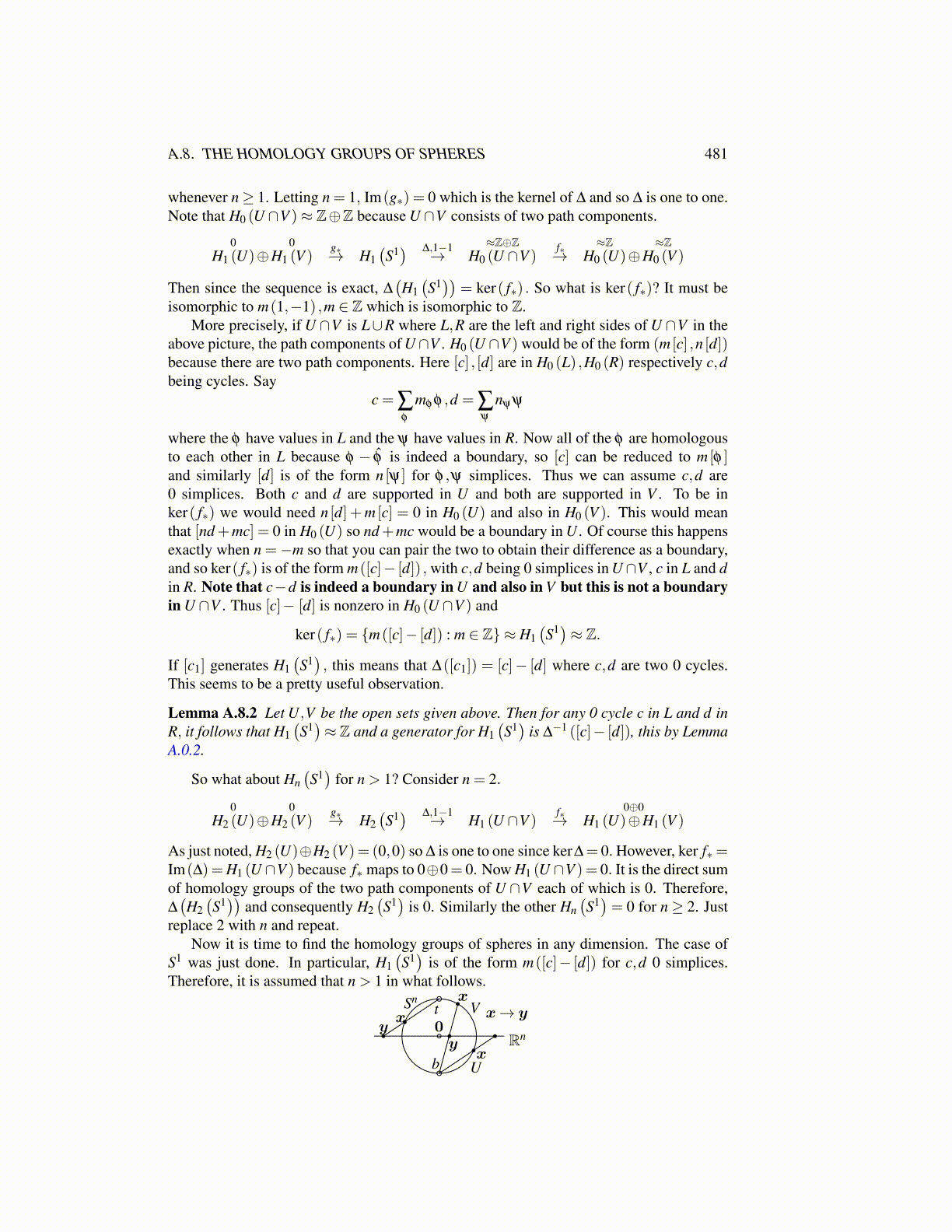
A.8. THE HOMOLOGY GROUPS OF SPHERES 481
whenever n≥ 1. Letting n = 1, Im(g∗) = 0 which is the kernel of ∆ and so ∆ is one to one.Note that H0 (U ∩V )≈ Z⊕Z because U ∩V consists of two path components.
0H1 (U)⊕
0H1 (V )
g∗→ H1(S1) ∆,1−1→
≈Z⊕ZH0 (U ∩V )
f∗→≈Z
H0 (U)⊕≈Z
H0 (V )
Then since the sequence is exact, ∆(H1(S1))
= ker( f∗) . So what is ker( f∗)? It must beisomorphic to m(1,−1) ,m ∈ Z which is isomorphic to Z.
More precisely, if U ∩V is L∪R where L,R are the left and right sides of U ∩V in theabove picture, the path components of U ∩V . H0 (U ∩V ) would be of the form (m [c] ,n [d])because there are two path components. Here [c] , [d] are in H0 (L) ,H0 (R) respectively c,dbeing cycles. Say
c = ∑φ
mφ φ ,d = ∑ψ
nψ ψ
where the φ have values in L and the ψ have values in R. Now all of the φ are homologousto each other in L because φ − φ̂ is indeed a boundary, so [c] can be reduced to m [φ ]and similarly [d] is of the form n [ψ] for φ ,ψ simplices. Thus we can assume c,d are0 simplices. Both c and d are supported in U and both are supported in V . To be inker( f∗) we would need n [d] +m [c] = 0 in H0 (U) and also in H0 (V ). This would meanthat [nd +mc] = 0 in H0 (U) so nd+mc would be a boundary in U . Of course this happensexactly when n =−m so that you can pair the two to obtain their difference as a boundary,and so ker( f∗) is of the form m([c]− [d]) , with c,d being 0 simplices in U ∩V , c in L and din R. Note that c−d is indeed a boundary in U and also in V but this is not a boundaryin U ∩V . Thus [c]− [d] is nonzero in H0 (U ∩V ) and
ker( f∗) = {m([c]− [d]) : m ∈ Z} ≈ H1(S1)≈ Z.
If [c1] generates H1(S1), this means that ∆([c1]) = [c]− [d] where c,d are two 0 cycles.
This seems to be a pretty useful observation.
Lemma A.8.2 Let U,V be the open sets given above. Then for any 0 cycle c in L and d inR, it follows that H1
(S1)≈ Z and a generator for H1
(S1)
is ∆−1 ([c]− [d]), this by LemmaA.0.2.
So what about Hn(S1)
for n > 1? Consider n = 2.
0H2 (U)⊕
0H2 (V )
g∗→ H2(S1) ∆,1−1→ H1 (U ∩V )
f∗→0⊕0
H1 (U)⊕H1 (V )
As just noted, H2 (U)⊕H2 (V )= (0,0) so ∆ is one to one since ker∆= 0. However, ker f∗=Im(∆) =H1 (U ∩V ) because f∗ maps to 0⊕0= 0. Now H1 (U ∩V ) = 0. It is the direct sumof homology groups of the two path components of U ∩V each of which is 0. Therefore,∆(H2(S1))
and consequently H2(S1)
is 0. Similarly the other Hn(S1)= 0 for n≥ 2. Just
replace 2 with n and repeat.Now it is time to find the homology groups of spheres in any dimension. The case of
S1 was just done. In particular, H1(S1)
is of the form m([c]− [d]) for c,d 0 simplices.Therefore, it is assumed that n > 1 in what follows.
Rn
Snt
b
xy
U
V0y
xx→ y
x